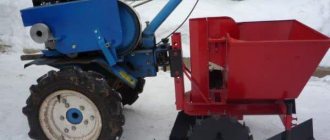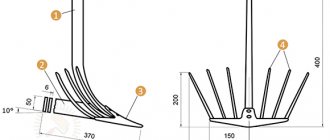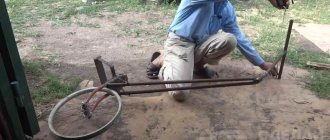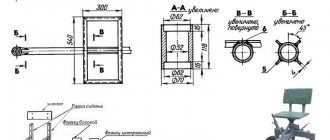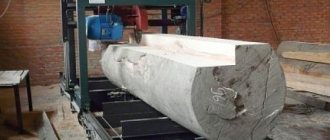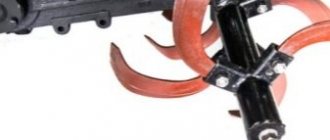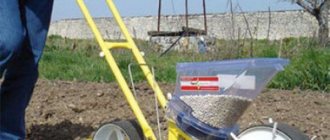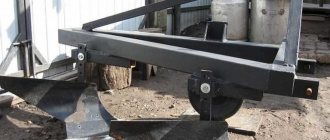The process of planting potatoes seems to be quite labor-intensive work, especially if the garden area is quite large. You can’t do this without outside help, because doing this alone is not only difficult, but also takes a long time.
What should those who do not have the opportunity to involve their friends or relatives in planting do? The answer is simple - you need to use those automated units that specialize in such purposes.
Recently, walk-behind tractors have become widespread, being real “helpers” for farmers in running their farms. Using this unit, you can not only plow land, but also plant potato tubers.
However, in this case, you cannot do without additional equipment. For this purpose, specialized stores offer a fairly wide range of potato planters designed for aggregation with a walk-behind tractor (such as the KSM 4 potato planter).
But not everyone has extra funds to purchase such equipment, so a reasonable question arises - how to make a potato planter for a walk-behind tractor with your own hands? Let's try to answer this question in this article.
Device
A potato planter for a walk-behind tractor can be easily made at home, using fairly traditional tools, as well as those components that almost every rural resident has on their farm (read about spare parts and parts for KSM 4 here).
The operating principle and purpose of a homemade potato planter for a walk-behind tractor is identical to factory analogues, such as a potato planter for a mini tractor, for a tractor, bomet, l 207, for MTZ.
Homemade potato planter
In general, this device has the following structural elements, which we will need to manufacture:
- frame structure on which the remaining elements of the unit will be located;
- container in which the planting potatoes will be located;
- a mechanism that will operate the system for planting tubers in holes;
- rippers that dig holes;
- wheelbase;
- elements that bury holes after planting potato tubers in them.
In principle, this is the minimum that we need to make a fairly simple design of a potato planter at home.
The process of assembling such a device itself involves quite a lot of scope for action, because you can add an additional tank to the design, which will contain fertilizer, and also make not one, but two elements for planting tubers.
Of course, this will lead to the weight of the entire structure, slightly reducing its maneuverability and performance. Therefore, you need to think several times before adding additional elements to the potato planter.
For more information about a homemade potato planter for a walk-behind tractor, watch the video:
Additional Tips and Warnings
Due to the fact that the weight of a homemade potato planter is quite impressive, it is necessary to install additional weighting on the walk-behind tractor, which will not allow it to tip over. In addition, there are certain recommendations that help make the process of planting potatoes more simplified.
Potato container
You can additionally put a couple of bags of potatoes on the container in which the tubers will be placed for planting, so as not to waste time filling in new ones. It is recommended to drive at low speed, approximately one kilometer per hour.
The closing discs can be adjusted, for which they need to be rotated along the axis of rotation. In addition, you can adjust the inter-row distance and the location of potato tubers from each other.
To do this you need:
- Loosen the stepladders that hold the posts to the supports.
- Slightly adjust the angle of entry of the planting elements into the soil.
Assembling a homemade potato planter is advisable in cases where there is not enough money to purchase a ready-made device in specialized stores.
If we consider that the average cost of a potato planter is about 13 thousand rubles, then making it at home becomes more and more justified.
Necessary materials
In principle, to make a homemade potato planter, the materials that many summer residents have on their farms are sufficient. At worst, we can go to the nearest landfill, where we can find a lot of parts and related materials that may be useful to us during assembly.
Required material
Here is an approximate list of what we may need:
- sheet metal of various widths;
- bolts and nuts;
- welding machine;
- Bulgarian;
- wheels;
- channels, etc.
As we can see, we will need quite a lot of metal, which in itself implies the use of a welding machine. Therefore, if you do not have the skill to work with it, then assembling a homemade potato planter will not be available to you.
The list of required materials does not include various components that will be discussed in detail in the process of describing the technology for constructing this device.
Design and principle of operation of potato planters for walk-behind tractors
Such devices consist of:
- frames;
- a bunker in which potatoes intended for planting are placed;
- wheel base;
- a mechanism that ensures loosening of the soil and planting tubers on the site.
Most models have a similar device
Attention! In addition to those listed, other elements may be present - for example, a container for fertilizer.
The operating principle of such a device is very simple. The sprocket mounted on a wheel base is part of a chain lift. When the wheels rotate, the tubers from the hopper rise through a vertical pipe and then are dropped down into the prepared furrow.
Tips for use
Before loosening the soil in the beds, it is necessary to remove weeds. It can be left on the site to prevent moisture evaporation under the sun's rays, using it as mulch. After clearing the weeds, they begin to work. To properly hill up potatoes, you need to adjust the device to the desired size of the bed. To do this, the distance between the cutters is set on the disk device, and the penetration angle is set on the plow device. The latter is changed by rotating the lanyard.
For your information! A properly adjusted tool will not damage plant roots. The effort required to move it will be minimal.
When the hiller is set up, they make a test run in a place where there are no plants. After obtaining satisfactory results, you can begin to work. It is better to carry out cultivation in cloudy weather or in the evening: moisture loss from the soil will be minimal, and exposed tubers will not get sunburned. If after the first hilling a ridge of insufficient height has formed, make a second pass. The hard earthen crust that remains after processing is broken up with a hoe or hoe.
You may be interested in: How to hill potatoes with a cultivator, walk-behind tractor, disk hiller: tips Hilling potatoes is a mandatory procedure for proper cultivation of a vegetable crop. This procedure…Read more…
Planting process
Potato tubers are planted in a furrow made in advance using a walk-behind tractor. Thus, first you need to use it to plow the garden, then you need to attach a trailed potato planter to the back of the walk-behind tractor, place the tubers in its hopper and plant the potatoes.
It is impossible to simultaneously cut a furrow and plant tubers with a potato planter using a conventional household walk-behind tractor. Only a powerful diesel walk-behind tractor or mini-tractor can perform such operations.
The main types of potato planters for walk-behind tractors
Such devices can be single- or double-row. The first type is suitable for a small area. It has small dimensions and low productivity.
Two-row models are more productive
Some potato planters for walk-behind tractors allow you to plant sprouted potato tubers. Others focus exclusively on unsprouted ones. Also, a number of models allow connection to a certain line of walk-behind tractors. Others, if they have a universal hitch, can be aggregated with various units. The loading hopper can be rectangular or cone-shaped.
Depending on the type of tuber feeding, such attachments are usually divided into units with:
- flat belt system. Tubers are planted using horizontal belts;
- spoon system. To serve potatoes, a design consisting of spoons attached to a belt is used;
- shaped belts that have a special recess that resembles a spoon. An operator must be present when planting, but there is no fear of damaging the tubers;
- piercing mechanism. Such devices are relevant when planting cut potatoes;
- multi-belt design. Such attachments allow you to simultaneously plant two rows of potatoes.
Feeding mechanism may vary
Kinds
The potato planters themselves can differ from each other in a number of distinctive features and criteria. Let's consider each gradation separately.
DIY potato planter
So, potato planters may differ in the type of technological process:
- Units that plant sprouted tubers. Such fruits have developed sprouts that can sprout within 20 days from the moment they are planted in the soil.
- Potato planters that plant unsprouted tubers. Of course, not everyone has the opportunity to store potatoes in the right conditions when sprouts form normally. For such cases, similar units are used.
- Mixed potato planters.
Potato planters may differ in the number of rows:
- Single-row potato planters. Such a device is connected to a mini tractor (see here), having one potato tank. The capacity of such a bunker for tubers will reach, on average, 140 kg.
For more information about the single-row potato planter, watch the video:
- Double row units. It has the same design as the single-row potato planter.
- Both types of units are used for planting potatoes in relatively small areas of the territory, developing a fairly high speed - up to 15 km/h. Due to the fact that they have more compact dimensions, they are much more mobile than their 4-row counterparts.
- 4-row potato planters. Such units are capable of planting potatoes on an area of 2 hectares in about one hour of work. They have a bunker that can hold about 550 kg of tubers, and also have four planting elements.
In addition, potato planters can differ in the type of connection they have to the driving unit:
- trailed;
- semi-mounted;
- mounted
What devices are needed?
To plant potato tubers, it is clear that one single walk-behind tractor will not be enough; additional devices will be required, in particular a potato planter. This equipment will allow you to carry out the procedure efficiently and quickly, without the use of heavy physical labor.
The effectiveness of this approach also lies in the fact that the potato planter may well be homemade. That is, anyone can make the device with their own hands: it is not necessary to buy a finished product. This allows you to optimally select the dimensions of the potato planter for the walk-behind tractor that will meet your needs.
Therefore, we present a diagram and drawing of such a device in order to understand what kind of unit you can get in the end if you make it yourself.
Manual hiller for potatoes: diagrams and recommendations for self-assembly
Potatoes have always been and are an important crop that many summer residents grow on their property. Of course, potatoes grown on our own are always very tasty and of high quality.
However, do not forget that in order to get tubers of excellent quality, you need to hill them during the growing process. This is due to the fact that in loosened soil the roots of the plant grow, and due to this, a large number of potato tubers are formed.
Hilling is usually done using hoes. If the area is large, then this process takes a lot of time and effort. Therefore, it is worth thinking about a more convenient device for hilling.
A manual potato hiller is the most optimal device for loosening the soil. In addition, with the help of this simple device you can loosen a large plot of land measuring almost 10 acres in a matter of time.
So what is this interesting tool and how can you make it yourself? In order to understand this issue, it is worth considering all the properties and advantages of this device.
Drawings of a potato planter for a walk-behind tractor.
Calculation of gears of the chain rotation mechanism with potato planter bowls.
The frame of the potato planter is welded from a profile pipe; a tank from a Soviet Riga washing machine or a similar cone-shaped container can be used as a hopper.
Bearings with a lower axle and a drive sprocket for the chain and vertical posts for the upper axle with a sprocket are attached to the frame.
Bucket rings made of 6 mm wire are welded to the sides of the chain; the buckets must be welded in such a way as not to weld the connections between the chain links.
To prevent the tubers from falling out of the buckets prematurely, you need to install a guide pipe; alternatively, you can use a plastic drain pipe with a diameter of 100 mm.
To fill the furrow, two rotary disks with the ability to adjust the angles are installed.
Installation diagram of the planter on a walk-behind tractor.
I recommend watching a video of making a homemade potato planter.
Video: homemade potato planter in action.
DIY making
You can choose a potato planter and other necessary attachments in a specialized store, or you can make such a device at home. You just need to have some plumbing skills and purchase the necessary materials to make a mounting device for a walk-behind tractor.
Tools and materials
To make a potato planter with your own hands, you will need to purchase:
- Axles, bicycle chain (or chain from a car engine), bearings for wheel movement, making a chain elevator.
- Metal sheet for making a bunker.
- Square or round metal profile for mounting a frame holder and other purposes.
- Welding machine for firmly connecting potato planter elements to each other.
- Several electrodes for welding.
- Grinder and discs for cutting metal sheets into the required parts.
- An electric drill and drill bits for it for drilling work.
- Fastening elements to add strength to the device.
- Nuts and screws for mounting the structure.
- Wire (several meters) for fastening some elements of the device.
- Sandpaper or file for sanding and cleaning parts.
Before you start assembling the potato planter, you need to carefully study the drawing, think about the dimensions of the future device, its appearance, and the method of attachment to the walk-behind tractor. The dimensions of the planter should not be very large so that the design does not become too bulky.
The volume of the bunker for filling tubers is determined based on the calculation of the double length of the bed. The volume of the container should be enough for a walk-behind tractor with a bunker filled with potatoes to pass two furrows and return to the place of re-loading.
Specific points of using a potato planter for a walk-behind tractor
If you decide to use a potato planter for a walk-behind tractor, familiarize yourself with the features of its use in order to understand how to set up the device and the planting process itself.
The potato planter must be set up correctly
Setting up a walk-behind tractor and potato planter
Before planting, the soil is plowed, harrowed and moistened. The unit and device are configured to ensure the following points:
- forming a furrow of suitable depth;
- ensuring sufficient distance between furrows;
- stable operation of the planting material supply mechanism.
Recommendations for planting potatoes
To ensure that the walk-behind tractor does not change its position and is stable due to the large weight of the potato planter, you should immediately take care of the ballast, which is attached to the front of the unit. The speed of the unit should be about 1 km/h. Forming a furrow and covering the planted potatoes with soil is carried out using special sealing discs. Special cultivation paws should prevent the formation of marks after the walk-behind tractor passes.
If possible, planting potatoes should be uniform in size. It should be carefully prepared for the growing process.
TOP 3 factory models of potato planters
Among the factory models of potato planters for walk-behind tractors, the following are the most popular:
Important! The name of these models stands for single-row potato planter (PT), the number “1” after the hyphen. The additional letters “M” and “A” indicate modifications (improvements) of previously released models.
- Type – single-row, trailed;
- Weight –25 kg;
- Track – 700 mm;
- Hopper capacity – 40 l;
- Productivity – 0.15-0.2 g/hour;
- The required power of the walk-behind tractor is from 6 hp;
- Price – 12000-14500 rub.
Potato planting unit KS-1A
- Type – single-row, trailed;
- Weight –33 kg;
- Track – 600 mm;
- Hopper capacity – 34 l;
- Productivity – 0.25 g/hour;
- The required power of the walk-behind tractor is from 6 hp;
- Price – 15,000-16,000 rubles.
KSM-1A – productive and convenient potato planter
- Type – single-row, trailed;
- Weight – 44 kg;
- Track – 600 mm;
- Hopper capacity – 41 l;
- Productivity –0.25 g/hour;
- The required power of the walk-behind tractor is from 6 hp;
- Price – 15500-16000 rub.
All these models work well with walk-behind tractors, both domestic (MTZ, Neva, Salyut) and foreign-made (Viking, CAIMAN, Daewoo).
Important! You can buy one of the models listed above in almost any large and medium-sized Russian city. But the most favorable prices are in such large cities as Moscow, St. Petersburg, Yekaterinburg, Novosibirsk. This is explained by high competition among a large number of sellers: firms, private entrepreneurs, which causes a wide variety of prices, seasonal discounts, and the possibility of purchasing equipment in installments or on credit.
Thus, a homemade inexpensive potato planter for a walk-behind tractor is a very convenient, easy-to-use unit, but at the same time it greatly facilitates the work of a summer resident or small farmer. Made from materials available to everyone, such a homemade product, compared to store-bought counterparts, will have a cost several times lower, while not being inferior to them in quality and reliability.
Design and principle of operation
All such units have almost the same design. This is necessarily a strong frame onto which the remaining components are attached, consisting of an axle with lugs, two gears, a conveyor with cells for root crops and a supply pipe. A small plow is also attached to the frame to create a furrow into which the tubers are placed at the same distance. And behind the frame, a disk hiller is installed to fill the potatoes with soil. The entire landing process occurs automatically.
The principle of operation is simple and is as follows. When the walk-behind tractor moves, the planter's lugs, on the axis of which the sprocket is located, begin to rotate. It is connected to the top gear via a chain. It is precisely the conveyor for feeding tubers into the furrow. Cells welded to the chain capture the potatoes and feed them into the guide pipe. At the very bottom there is a small plow. He makes a furrow in which the potatoes fall. A hiller is installed behind the frame, which backfills root crops.
The distance between tubers in a row is from 35 to 40 cm. All adjustments are made during the manufacture of the unit. Then tests are carried out and deficiencies are eliminated.
Testing a planter in the garden
After production, the potato planter must be tested and adjusted for normal planting. The unit must meet the following parameters:
- the depth of the tuber is 12-15 cm. This is regulated by the height of the furrow plow;
- the distance between potatoes in a row is 30-40 cm. This depends on the diameter of the lugs and the number of conveyor cells. This calculation is made at the stage of manufacturing the unit;
- the distance between potato rows is 60-70 cm.
In addition, it is necessary to carefully select seed material. The tubers should be the same size, fit freely into the planter cell and not have long shoots.
These are optimal conditions for good germination and, therefore, a large harvest.
What track should a walk-behind tractor have when planting potatoes?
To plant potatoes with a walk-behind tractor, you need to observe a number of technical nuances, among which the most important are the track width, planting depth and distance between tubers.
The farmer needs to configure the unit to the following parameters:
- The track width should be from 55 to 65 cm, which will ensure normal crop growth and easy care.
- The distance between each hole should be from 25 to 30 cm.
- Planting depth – from 10 to 15 cm.
It is important to ensure that the track width when planting the potato planter is equal and does not stray. To do this, initially set up your unit; you can also pull ropes along which you can monitor the evenness and correctness of the furrows.
What is required for production
To make a walk-behind potato planter, you do not need any rare or expensive tool.
The simplest version of this device consists of six main elements:
- wheels;
- tuning mechanism;
- loosening mechanism;
- gear systems;
- bunkers for root crops;
- frames
The device can be improved by adding new parts to its design, for example, a container for fertilizers or a pair of landing modules. However, as the number of parts increases, the walk-behind tractor becomes heavier, and therefore becomes more difficult to control during operation.
To make your own potato planter for a walk-behind tractor, you usually use a tank from an old washing machine. It acts as a bunker for potatoes. Self-taught craftsmen also use a metal corner, steel wire, chain, gear, fittings, a pair of wheels from old vehicles, and a channel.
The tools you will need are the simplest:
- hammer;
- drill;
- spanners;
- welding machine;
- screwdriver;
- wire cutters;
- Bulgarian.
This is the required minimum for making a homemade unit. Essentially, a self-made potato planter is a cart attached to a walk-behind tractor.
But only at first glance the design seems simple: if you look closely, you can find many features in it.
Instructions
Do-it-yourself homemade potato planters for walk-behind tractors are a regular cart on wheels, which is attached to a walk-behind tractor. The apparent simplicity is a little deceptive, because the design of this unit has its own nuances and features that are worth paying attention to.
Frame design
You need to start assembly by making the frame structure. It will consist of channels welded together, as well as longitudinally located spars, which are connected by three transverse elements.
Thanks to a lawn mower, you can trim the grass and remove weeds - this is a suitable device for mowing unnecessary plants near the fence, at home, between the rows in the garden in a flower bed, and so on. Learn how to spool a line onto your lawnmower here.
The MAZ-500 can rightfully be considered one of the iconic cars of the Soviet period, which became the first cabover truck produced in the Soviet Union. MAZ-500 is a Minsk legend from the 60s.
Cultivation is on the list of priority tasks for any tiller, as it helps prevent the appearance of weeds, at least in large quantities, and helps saturate the soil with oxygen, thanks to loosening. Here's how to make a cultivator yourself.
There will be an arch and a fork in front, and on the sides of the structure there will be racks of elements for planting and digging holes. The wheels of the potato planter must be equipped with lugs. Between them there is a wooden disk 6 cm thick with four semicircular grooves located on it.
This disk will capture potato tubers, moving them into the dug holes.
Next you need to make a container for potatoes - a bunker. It can also be made from plywood, but for structural strength it is best to use sheet metal 3 mm thick.
The four sides of the hopper are measured and then cut out. They are connected by welding. The bottom can be covered with rubber so that the potato tubers are not damaged. It is necessary to strengthen the frame with steel strips, placing them from the middle transverse part to the arch in front.
There you need to weld linings and corners with a thickness of 4 mm. DIY drawings of a potato planter for a walk-behind tractor, which can be found on the Internet, describe this process in sufficient detail. Next, you need to attach a support and a footrest, consisting of a sheet of metal 5 mm thick, to the side members.
Making a seat
We make a seat. To do this, we need a metal corner with dimensions of 4.5 × 4.5 × 0.4 cm. To this support we need to attach boards covered with foam rubber for greater comfort. For the wheel axle, you can use a steel pipe that is sized to fit the frame.
At the ends there should be spikes secured with steel pins. As wheels, you can use any wheels from old equipment that has served its purpose. To hold the rippers, a metal rod measuring 5x5x0.5 cm is used.
On the sides of this rod there are elements holding the blade struts. They are made from metal plates 0.5 cm thick. As a seeder, you can use a regular 10 cm pipe, the wall thickness of which will be about 0.3 cm.
A furrow cutter will be located at the bottom of this structure. Digging elements, for which discs from a seeder can be used, must have two bearings. In principle, this description is quite schematic, with an approximate indication of dimensions and parameters.
On the Internet you can find quite a lot of detailed drawings, where other markings are indicated, so there are no strict recommendations in this process.
How to make a manual plow-type hiller
The list of tools for making a manual potato hiller with your own hands does not differ from the previous one. Materials are also purchased in advance.
Table 4. List of blanks for making a disk hiller.
| Materials | Size, mm | Quantity, pcs. | |
| Electric-welded steel pipe by standard size | 21 x 2.2 | 400 | 1 |
| 1000 | 1 | ||
| 1700 | 1 | ||
| 32 x 2.5 | 700 | 1 | |
| 1000 | 1 | ||
| 45 x 6.5 | 1000 | 1 | |
| Steel sheet 3 mm thick | 400 x 1000 | 1 | |
| Electrodes E46-ANO | 3 (diameter) | 1 kg | |
| M10 bolts | 25 | 4 | |
| Nuts M10 | — | 4 | |
| Fabric belt | 2000 | 1 | |
| Lanyard | 250 | 1 |
The lister device for tillage consists of the following components: a two-blade working body, a stand, front and rear handles. Preparation stages:
- The stand is made of pipe 45 x 1000 mm. It is bent in the middle at an angle of 30°. On one side, five holes with a diameter of 12 mm are drilled in increments of 50. On the other, two ears are welded for attaching the front handle and lanyard.
- The rear handle is made from a 21 x 1000 mm pipe. On both sides it is bent at an angle of 90° at a distance of 150 mm from the edge. A 32 x 700 mm pipe is welded to it in the middle with its end and five holes are drilled. The spacing of the latter is 50 mm.
- The front handle is made of pipes 21 x 1700 mm. They are bent in the middle at an angle of 45°. They weld together. A 21 x 500 mm pipe is attached to the joint. An eye for the lanyard is welded in the upper part, and at the end - for fastening to the rack. Brackets for the traction belt are attached to the side handles.
- The working body is cut out of sheet iron. To do this, the outline of the workpiece is drawn on the metal and cut with a grinder. The parts are given a smooth bend in the vertical plane and welded together. The front cutting edge is sharpened at an angle of 45°. Welded to the stand.
After finishing the work, the welds are cleaned with a grinder or a file, scale and rust are removed, and covered with paint. For convenience, the handles are wrapped with electrical tape; you can put on rubber bicycle grips. Perform final assembly:
- Insert the front handle into the eyelet on the stand. They are fastened with a bolt and nut.
- Attach the lanyard.
- Attach the rear handle.
- Thread the belt into the brackets and adjust its length.
Types and descriptions of seeders for walk-behind tractors
Planting garlic and other crops with a walk-behind tractor can be done with different seeders. Below we will consider the design features of each type of seeders for walk-behind tractors in more detail.
Row seeders
Devices of this kind are used for row sowing and simultaneous placement of seeds into the soil. Depending on the purpose, on sale there is a row seeder for a walk-behind tractor for garlic, a corn seeder for a walk-behind tractor, and a universal row seeder, which is suitable for sowing seeds of any crops.
The main elements of row seeders on a walk-behind tractor are coulters and sowing devices. The coulters are equipped with special “legs” or chains, which are necessary for embedding seeds into the ground. For operation in areas with heavy soils, row seeders with disc coulters are used, and for use on loose soil, devices with anchor coulters are used. The main advantages of row seeders include the uniformity of sowing and the optimal depth of placement of planting material.
Nest seeders
Devices of this kind are optimally suited in cases where the farmer needs to sow crops precisely into holes or nests prepared in advance. Nest seeders for walk-behind tractors can be successfully used for sowing seeds of garlic, onions and other small planting material.
The advantages of nest seeders for walk-behind tractors include ease of use. Such equipment is characterized by small dimensions and weight. However, this type of seeders is very slow, which is why it takes a lot of time to work with them.
Square nest seeders
These grain seeders for walk-behind tractors make nests at pre-marked points in conventional squares or rectangles. Such structures consist of a frame, support wheels, a mechanism for unwinding measuring wire from a reel and sowing sections.
The advantages of these devices for a walk-behind tractor include the ability to cover a large area of territory when working. Among the disadvantages of such seeders is their large mass due to the presence of a large number of metal elements in their design. These seeders are not capable of developing high speed, which leads to loss of time when working with it.
Broadcast seeders
Devices of this type have a simple and reliable design, do not require special care and rarely require repairs. The principle of operation of broadcast seeders on a walk-behind tractor is very simple: during operation, seeds taken by a special disk are subject to pressure, as a result of which they are thrown out of the seeder onto the site.
The advantages of such devices include high productivity. Among the disadvantages, it is worth highlighting the difficulties when using seeders at the edge of the plot, in which most of the seeds are thrown outside the garden.
Dotted seeders
These devices are used for sowing seeds of garlic, onions, corn and legumes in pre-prepared nests, which are located at a certain distance from each other. Despite the complex design and large dimensions, dotted seeders for walk-behind tractors are quite easy to operate.
The advantages of such devices include high precision during sowing and good productivity. Among the disadvantages, we should highlight the inability to use such seeders in areas with heavy clay soil.
Operating principle
The device is attached to the motor vehicle on the bracket of the coupling device (hitch), which does not have a bed. This is accomplished by means of a locking component - two screws and a flat washer. More comfortable and high-quality work is performed at the first reduced speed. This will make it possible to increase traction by reducing the forward speed.
The principle of operation of a disc implement for hilling is simple: the discs, when moving, grab the ground and form a roller during the hilling process, covering the vegetation with soil. The movement of the discs makes it possible to further crush the soil and loosen it.
The disk device for hilling has some advantages over its relatives: it builds ridges higher and more level, it is simpler and more interesting to operate, and energy costs are significantly lower. It is easier for an employee with such a device to work.
Of course, not everything is so wonderful. You always have to pay for convenience. And the cost of the disc hiller is proof of this. The cost of using a comfortable and easy-to-use disk device is approximately 3–4 times higher than other types.
The cost of agricultural implements depends on the following characteristics:
- thickness and transverse size of the disks;
- material of manufacture: ordinary metal or alloy steel;
- use of roller bearings or sliding bushings in the structure;
- setting device.
When purchasing a disc implement for hilling, all these points must be taken into account.
Taking into account that this equipment is not cheap, a natural question arises as to whether it is possible to make a homemade disk device for hilling a walk-behind tractor
Homemade seeder for walk-behind tractor: manufacturing features
In order to obtain a truly practical device after completing all the necessary procedures, you must:
- Two running wheels;
- Seed box;
- Screws and nails;
- Steel sheets;
- Rubber plates;
- Seeding roller;
- Self-tapping screws, tenons, steel angles;
- Two bearings and bracket.
The process itself is simple, but requires maximum concentration, so you need to pay attention to the following features:
- The seed box can be created from boards (wood) (thickness no more than 15 mm);
- To close them from the bottom, you can use steel overhead bottoms (1 mm thick);
- The walls themselves are connected using self-tapping screws, iron corners and spikes;
- Using nails, wooden linings (15 mm thick) are mounted on the bottom of the box walls;
- The process of placing the seeding roller in the walls and linings is accompanied by the creation of cutouts (semicircle shape). The fastening brackets are carefully screwed to the linings using screws;
- Special rubber plates, which are placed in inclined bottoms, help seeds fall out of the cells;
- The wheels of the created grain seeder for a walk-behind tractor (or corn) have 60 mm hubs;
- Special holes are created in the hubs (the diameter is similar to the seeding roller);
- The opener can be made from a sheet of iron and then attached to the brackets;
- You can adjust the depth at which the seeds will be placed by re-fastening the opener in special holes;
- A bracket is attached to the back wall of the seed box, serving as a “connecting link” between the device and the walk-behind tractor.
Sources
- https://MachinSpec.com/selskoxozyajstvennaya/kartofelesazhalka/samodelnaya-dlya-motobloka.html
- https://kalibrtractor.ru/spetstehnika/kartofelesazhalka-dlya-motobloka-svoimi-rukami.html
- https://tokar.guru/stanki-i-oborudovanie/motobloki/kartofelesazhalka-dlya-motobloka-izgotovlenie-svoimi-rukami.html
- https://dacktil.ru/motoblok/samodelnaya-kartofelesazhalka-dlya-motobloka.html
- https://www.samodelkindrug.ru/9007-2/
- https://pochini.guru/tehnika/izgotovlenie-kartofelesazhalki
- https://sotka.guru/dachnye-prisposobleniya/motobloki/izgotovlenie-kartofelesazhalki-dlya-motobloka-svoimi-rukami.html
[collapse]
